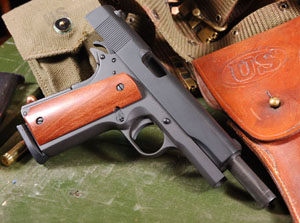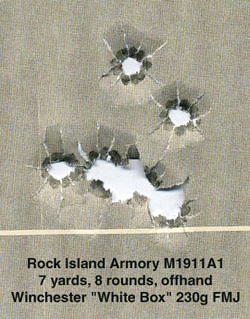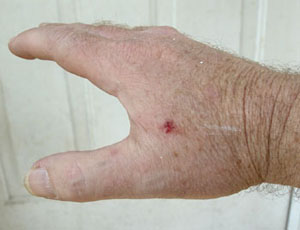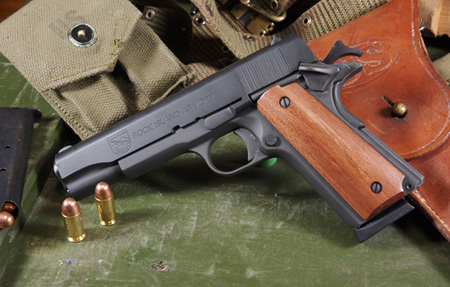By Syd

I was determined not to like this gun – Colt/Kimber/Springfield snobbery at work, I guess. I went at it with the intention of finding fault. At the same time, I love M1911A1’s, and precious few gun makers are building true M1911A1’s these days. They may look like them on the outside, but inside, they’re polluted with a bunch of lawyer-friendly, California suck-up perversions of the design, like Swartz safety firing pin blocks, external extractors, integrated locking systems and other “answers in search of a question” devices that degrade the trigger and add unnecessary complexity to the design. Personally, I really like the M1911A1 design, which is sometimes referred to as the “Series 70” format (even though “Series 70” and “M1911A1” are really two different pistols). People use “Series 70” to mean 1911’s that don’t have firing pin blocks (or in Kimber parlance, Series 1). (Go here to get a complete description of the Series 70 Colt.) Kimber had taken to adding these “improvements” with an external extractor and a Swartz-type firing pin block, but the Marines rang their bells when they ordered a batch of 1911’s from Kimber, but specified that they should have no firing pin blocks or full length guide rods, and they should have internal extractors – in other words, they should be real M1911’s and not the lawyer friendly crap that has developed recently. So, even though my Colt/Kimber/Springfield snobbery was blazing bright, there was some serious sympathy for an outfit that is still willing to build a true M1911A1, and RIA (actually Armscor of the Philippines through their subsidiary, Twin Pines) is doing that.
The RIA guns are being sold at extremely attractive prices. The “M1911A1” is selling for about $350-$370 and that price point is generating a lot of interest, especially when guns like the Springfield Mil-Spec are commanding $560 and most Kimber and Colt models are going for $800+.
There are some ways that the RIA M1911A1 is not a true M1911A1. The most obvious is that it has a flat mainspring housing. The G.I. M1911A1 has a curved mainspring housing. Contemporary 1911 shooters seem to prefer the flat mainspring housing which was characteristic of the older M1911 over the curved housing of the WW II era guns. The RIA pistol, like most modern production 1911’s, has a lowered ejection port with the scallop relief to the rear which is a good idea for reliability, but is not characteristic of the G.I. gun. It has a beveled magazine well and a somewhat enlarged thumb safety flange – again, modern modifications that make sense, but which were not found on the G.I. gun. It also has smooth wood grips rather than checkered bakelite. The RIA is like the M1911A1 in that it is parkerized, has the short trigger of the M1911A1, has authentic sights, short guide rod and spring plug, no firing pin block, and a mil-spec trigger of about 5.5-6 lbs.
First Test

It shot really well close. At seven yards I got a ragged hole. At 25 yards I got a pattern the size of a cantaloupe 8″ low at 8 o’clock. (By way of comparison, I shoot a baseball-sized pattern at point of aim at 25 yards with the SA XD 9mm at this same range under similar lighting conditions). It could have been my eyes and those tiny sights in the indoor range. I’m not ready to blame that totally on the gun yet. Probably a bit more testing is in order. I did the “magazine from hell” test (running every weird old magazine in my collection through it for reliability testing) and it only had one problem – a no-name Chinese knock-off magazine failed to lock back on the last round. There were no failures to feed (FTF). I did nothing to prep this gun for the test. I just took it out of the box, wiped the packing oil off of the outside and fired it – no lube, cleaning or “fluff & buff.” The only real problem was that I got some bitchin’ hammer bite. I don’t usually get hammer bite with M1911A1’s but this one sure did. When I got home, there was blood on the hammer flange and beavertail. All in all, it was a pretty decent performance for a $350 pistol. It was better than I expected it to be.
Second Test
Without cleaning it, I took it to a training session. For this session the RIA performed in the second gun role, with the trusty Combat Commander as the primary. I shot about half of the session with it, around 50 rounds or so. Again, the RIA performed flawlessly; again there was bitchin’ hammer bite.

Third Test
I remembered to grind off the sharp end of the hammer this time, but aside from a bit of wipe off when I took the hammer out of the gun, I still had not cleaned or lubed it. This session was at an indoor range and I ran 100 rounds of Winchester White Box through the gun. Again, it performed without a single bobble or hiccough. That made approximately 250 rounds of hardball through a new gun, without any cleaning or maintenance. All ammo was Winchester “White Box.” I have to admit that I’m warming up to the gun at this point.
Critique
There’s no such thing as a free lunch, and you would expect that certain corners might be cut in order to keep the pistol in the $350 range when most other M1911’s are bringing $800 and up. If you want to find nits to pick, you can. The sights are very authentic narrow blade sights like those used on the G.I. guns. In the dim light of the indoor range, they were hard to pick up. The smooth wood grips strike me as a little chintzy. Like many guns these days, the RIA has a number of MIM (metal injection molding) parts. If you look at the MIM parts with a 10x loupe, you will notice tiny surface imperfections like pits that appear to be the result of not quite enough polishing after the part came out of the mold. Also, a gun billed as an “M1911A1” should have an arched mainspring housing rather than a flat one. There seems to be a collective decision in the 1911 universe that we all prefer flat mainspring housings over arched ones. It really depends on an individual’s hand shape and geometry. Flat MSH’s aren’t perfect for everyone. The slide and frame are castings rather than bar-stock milling. I know for a lot of folks this is a negative, but you have to keep reminding yourself, “$350.” Last, if you look at a real government issue M1911A1, you will notice that the finish is dark gray with green and brownish tints. Like most “mil-spec” 1911 clones, the parkerization on the Rock Island Armory gun is black. Personally I like the black, but it’s not completely authentic.
What’s to Like?
Well, there’s price, price and did I mention price? For the money, I think this gun is an excellent value. The Rock Island Armory M1911A1 would be an excellent “first gun” for someone who wants to try out the M1911 platform without over-committing resources. Based on my testing so far, it has the reliability and accuracy to serve in the personal defense role. It might be able to go places with you where you wouldn’t want to take the “safe queens.” And, by the way, I still haven’t cleaned and lubed it, and it’s still running fine.


Comments, suggestions, contributions? Let me know